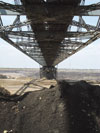

Three common factors head the list of security risks on mines according to the companies interviewed by Hi-Tech Security Solutions. Theft of copper cable, theft of explosives, and preventing the influx of illegal miners are all issues that have gained prominence and are accelerating in their level of threat to mine owners.
Theft on the mines is becoming increasingly focused, with well-organised syndicates working in collusion with employees to harvest precious metals, gems and copper cable and explosives.
Bill Young, chairman of Saflec, a company that has been involved with the design and manufacture of specialised detectors for precious metals and minerals, says “Collusion is a major problem for the mines, both in terms of employees stealing precious metals and minerals to resell to syndicates. By detecting the presence of even a miniscule portion of a stolen item before it can be removed, the mining houses will significantly reduce losses.”
Martin van der Westhuizen, business development manager: ADT Business Solutions, says that security has become an integral part of mining operations. “In addition to the revenue loss caused by cable theft, issues such as health and safety of employees and contractors; alcohol abuse; medical certification; management of staff; and protection of precious minerals at source, dominate.”

Steve Millard, CEO of General Systems Solutions, a security systems manufacturer, systems integrator and consultancy, says that the primary areas of focus for mine security vary depending on the region and type of mine. “We find on the gold mines that the exclusion of illegal miners is a predominant issue. Along with this is ensuring that only those people who hold valid certification are present on the mine. Access to areas such as the processing plants, where valuable elements are present, is forcing mines to increase their levels of security to deter theft.”

Access to contractors
Another weak link in the security chain is the access provided to contractors. Young believes that by installing a suitable multi-modal access control mechanism, the movement of both employees and visitors can be tracked and controlled to ensure that only authorised personnel are admitted to high-risk areas. “Then, by installing scanners at exit points from places like the gold room, any potential theft can be eliminated. Because the sophisticated scanners can detect small amounts of metal on or in the human body, it makes stealing precious metals too much of a hassle for would-be thieves.”
Kobus Maritz, national sales manager for Thorburn Security Solutions agrees that cable theft is still a major problem. “This causes excessive downtime and a resultant lack of productivity at mining operations. Another trend that currently prevails – the theft of explosives – seems to have been prompted by the fact that increased security levels have made it very difficult to pull off bank robberies and cash in transit heists. The opportunistic syndicates have returned to committing ATM bombings and have now latched onto the fact that they can gain access to commercial explosives through contacts they make on the mines.”
Maritz says that although there are regulated procedures in place, these are obviously insufficient to stem the flow of criminal activity. “One way of countering the theft of explosives is to decrease the links in the chain, so instead of offloading the explosives into a storage room, in many instances the deliveries are made directly to the shafts where the explosives are required. Mining companies also have to put very strict control measures into place to control explosives. This reduces the chance of interception occurring en route to the detonation destination.
“With regard to cable theft, the ideal is that all cable is marked in order for it to be identified and traced back to its owner if it is stolen, but cable suppliers have not yet found a solution to this. Other ways of deterring theft in the first place, include clamping the cable down in trenches. Electronic devices are being installed which would transmit an alarm code to security personnel if anyone tampers with the cables.”
Armed response
Maritz points out that there has been a swing away from security officers patrolling mine premises in favour of more targeted response teams who are heavily armed and protected against threats. “These response teams received specialised training and are quickly mobilised to the areas of risk, using all terrain vehicles. There is a huge difference between a Grade C security officer and a highly trained and qualified Grade A reaction officer who can secure a crime scene and give more assistance to the investigations officers. In this respect, ’less is more’ applies and has produced fantastic results at a number of mines.”
Francois Malan, MD of Camsecure says the primary issues the company has identified with regard to security on mines include problems with communication networks; perimeter protection and surveillance; suitably qualified and trained human resources; and accountability in terms of knowing where employees and contractors are located.
“Mines need to have a clear plan of action in place regarding the reaction of security personnel to the technology employed. This includes knowing how these employees will react to the standard operating procedures. A full audit trail is necessary to ensure accountability.”
He adds that it is advisable to use a common operating platform that will allow reporting from the various systems in the organisation. “I must caution though that because this can become very complex, risk managers need to identify a system that will allow the operator to readily interface with it, since his reaction to a situation is critical.”
Millard says there has been a great deal of development with regard to security performance on the mines in the past year. “The mines have definitely increased their physical security, both on the surface and underground. There has been a determined drive to increase perimeter security to close the gaps and electronics is playing a much bigger role in determining and allowing or disallowing access to specific areas.
“The ideal for access control is a turnstile that allows only one person at a time to enter, remains locked until such time that the person’s status is biometrically verified using a multi-spectral fingerprint reader, and then ensures that they are channelled to the correct area. We have developed a turnstile, known as the Zamma Zamma (translated roughly as illegal miner) proof turnstile, which is currently being rolled out at a number of gold and uranium mines with great success,” says Millard.
Van der Westhuizen adds that access control has evolved from being just a time and attendance system to one that incorporates biometric recognition with smartcard technology for the checking of competence certification; health certification; permission to enter specific areas and whether the person complies to the labour law in terms of the number of hours worked.
Colin Brown, global head of security at the De Beers Family of Companies, says the organisation faces two predominant security issues: illicit trade in diamonds and the security of their systems and information.
“We have tackled these issues by reducing the opportunity for theft to occur and by improving the actual diamond processing system in order to reduce exposure of personnel to the diamonds. In the process, we have embarked on extensive education of all employees on the subject of illicit trading and we have improved security programmes by providing niche training of security personnel.”
Brown explains that, in addition, De Beers constantly assesses its security employees to ensure that they are competent in their roles and further increases their exposure to other areas of the business by organising employee exchange programmes and professional development.
“We are increasing the use of technology, specifically with regard to De Beers’ own Scannex X-Ray scanners, at a number of our mines, with particular emphasis on the Botswana region. In addition we are undertaking a full overview of all technology deployed throughout our global facilities to drive improvements in availability, reliability and consistency of our security controls,” added Brown. “All of our internal actions are complemented by our liaison with appropriate law enforcement organisations.”
Brown said that the group is working towards a balance of shared services. “We are determining the capacities and capabilities of our own in-house team while at the same time acknowledging the role that consultants can play in the process.”
Pulling it together
Maritz believes that an holistic approach to security is required on the mines in terms of guarding, a reaction team, an investigation team and appropriate technology.
“Centralising information is becoming a major issue on mines so integration of the vertical security elements is important. Obviously some elements, such as fire, alarms and intrusion are more critical to monitor than other elements,” says Malan.
Millard notes that vertical integration is definitely a hot topic on the mines. “In addition to the elements normally associated with security, such as fire, alarms, intrusion and PA systems, more emphasis has been placed on the importance of integrating health and safety into the mix. It makes logical sense, since if safety issues cause downtime, productivity will be negatively impacted and the bottom line will be affected in the same way as with theft or loss through fire.
“An ideal solution integrates all aspects of people management including time and attendance, access control, biometrics, equipment issues, calibration checking, meal control, real-time text on video, employee messaging the enforcement of health and safety rules on a nonstop basis.”
“An integrated management platform that ties security and safety together means that operators no longer need to check banks of monitors. The required information is presented to the operator quickly and in a manner that is easy to understand. This means that fewer employees are required to monitor surveillance, thus reducing costs for the mines, without compromising quality,” says Van der Westhuizen.
Another benefit that derives from integration is the opportunity for process engineers to leverage the security system to provide valuable feedback on processes. “By utilising an existing security system, process staff can determine if a process has stopped or if there is a fault on the process line. The system will then alert the process department and security personnel who will act according to whether it is a process fault or potential theft.
“On the gold, diamond and platinum mines we are seeing a removal of internal doors, installation of virtual barriers, CCTV cameras and biometric/card access control systems to negate the need for physical barriers. The system is programmed in such a way that it effectively permits a person to enter a predetermined area for a specified period.”
Van der Westhuizen points out other knock-on benefits of integration. “Thermal cameras used for security monitoring can be used at the same time to detect fire or overheating of process equipment while integrated fire systems can monitor the release of hazardous acid and raise an alarm if the area is occupied. In both instances the system will be programmed to alert and mobilise reaction personnel.”
Technology at work
Maritz cites the use of night vision Flir cameras which have been successfully applied at a copper mine. “The quality of night vision cameras is incredible and all the bigger mines seem to be following this route, while the smaller mines are still using traditional cameras and methods to detect and monitor activity.”
Van der Westhuizen agrees that thermal cameras are receiving more attention. “Given that the area on which mines are situated normally comprises dense African bush, the thermal camera is ideal since it is capable of seeing beyond the vegetation.”
“The beauty of a thermal camera is that it can cover a large area, thus reducing the number of cameras, as well as additional lighting, required for surveillance. Add the increasing emphasis on superior video analytics that can pinpoint what caused an alarm, together with video verification, and you have a powerful monitoring system suited to the conditions endemic to mines,” says Malan.
Charles Laxton of Brand New Technologies says that due to the environmental conditions on site it is often difficult to use fingerprint biometric technology to control access onto a mine. “Fingerprints are often worn off or hands are dusty or oily, making it difficult to get an accurate reading with traditional methods of fingerprint scanning. What is needed is a reader that can read below the surface of the skin and is able to read through latex gloves and barrier creams like petroleum jelly.”

Laxton says that there is a place for both facial and iris recognition as methods of identifying employees and other visitors but their limitations should be noted. “Facial recognition has had great success in many applications, but cognisance needs to be taken of the changes that take place in the geometry of the facial planes as one ages. Regular updates need to be implemented to ensure that the historical image matches the current image.
“Iris recognition is a better option in this respect but, possibly its biggest downside is the cost that is involved.”
Millard believes that any technology used must be tailored to the local mining environment. “Apart from our very harsh environmental conditions, products should always be available without downtime, and be built rugged and durable to ensure that users cannot damage them. This in particular applies to biometrics devices.”
Van der Westhuizen says that a number of technologies have been introduced to enhance safety and security in the mining environment. “With the added emphasis on safety on site, alcohol monitoring can be incorporated into an access control system. As the employee places his fingerprint on the biometric reader or presents his card to a card reader, he is simultaneously required to blow into a breathalyser unit. If he exceeds the allowable limits, he will be refused access to the site.”
Centralised or remote monitoring and the evolution of IP technology mean that, while surveillance and access control takes place at the workface, the security monitoring function can be performed from a separate location. “This, for example, would allow all monitoring to occur cross border or at a distant location, thus freeing up mine employees to perform reaction duties,” says Van der Westhuizen.
“I believe that technology alone cannot achieve security. It is important to remember that there are always people involved in the process. The ideal is a highly motivated and trained person, sound technology, defined and codified processes and an effective quality management system,” says Brown. “We are investing a great deal of time in our data analysis capability to detect any anomalies that appear on our process and security systems and improve our situational awareness and security effectiveness. Increasingly our CCTV systems and philosophy are geared around a number of core issues impacting on our business including both security and compliance with OHS and operational protocols,” Brown adds.
Moving on
Maritz believes that perimeter control needs to be top of mind to ensure that any threat is contained before it can become a serious issue. “The biggest problem at present seems to arise from the correct identification of employees as opposed to interlopers using their access control cards.
“Risk and security managers need to keep their eye on the basics such as employing and training suitable security personnel, then adding the technology to support this human element. By combining the two elements, more success will be achieved in eliminating employee/criminal collusion, which accounts for 90% of all theft.”
He adds that mines need to have a comprehensive armed response protocol in place with regard to operational plans and reaction to incidents. Maritz cautions that where there is pressure on the mines to recruit people from the local community, there will generally be an increased exposure to the possibility of theft. “Firstly, the syndicates within these regions will attempt to plant one of their own members in mining companies and secondly, the terrain of the local environs is so familiar to local community members that once they leave the mine premises they can literally disappear.”
This will continue to be an issue, especially where smaller, new mines are opening. “In these instances the infrastructure comes under threat and syndicates target the theft of diesel and copper.”
Laxton reiterates that identity management will continue to be a growing concern. ”A weak access control system will not be able to attest to who has been left behind in a shaft at the end of a shift. This is problematic from both a safety perspective and with regard to illegal miners infiltrating the system. This is especially prevalent where cards are cloned and a system is not able to identify the cloning. By adding a form of identity recognition to the mix, the chances of this occurring are reduced.
“We are currently involved in a pilot study to determine the efficacy of linking RF tagging to an individual’s safety equipment. By tracking personnel in this manner, the mine will be able to ascertain who is doing what and where they are located. This will result in higher levels of safety and avoid the risk to life for all with regard to illegal miners.”
Malan believes that ensuring that the correct IT standards and infrastructure are in place is a good starting point for security systems. “The emphasis should be on systems that are easy to maintain and which can integrate a mine’s given technologies. Open platforms will ensure this compatibility and ease of interface.
“Often, one can piggyback a security network on a pre-existing IT infrastructure. This will not only provide assurance, since IT networks are generally high-performance and reliable, but by utilising existing networks, the cost savings can be substantial.”
“IP and edge technology are definitely here to stay and, together with smart cards that contain volumes of pertinent information about the holder, will make mitigating risk infinitely easier. Add to this the increasing sophistication of offsite surveillance footage storage on server farms or on the cloud, and security technology is centred on increasing productivity, reducing theft, increasing personnel safety and creating a totally managed environment,” says Van der Westhuizen.
“It is important to De Beers that the technology we use is correctly integrated to support our business processes and sustain a secure environment around our most high risk areas. Removing the opportunity for operational failure, both in operational and security processes, is a focus area in our operations,” says Brown.
| Tel: | +27 11 543 5800 |
| Email: | [email protected] |
| www: | www.technews.co.za |
| Articles: | More information and articles about Technews Publishing |

© Technews Publishing (Pty) Ltd. | All Rights Reserved.